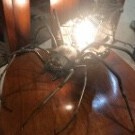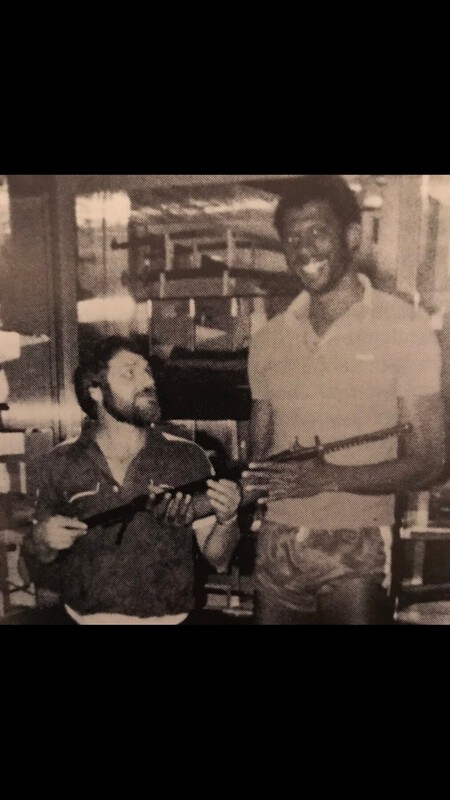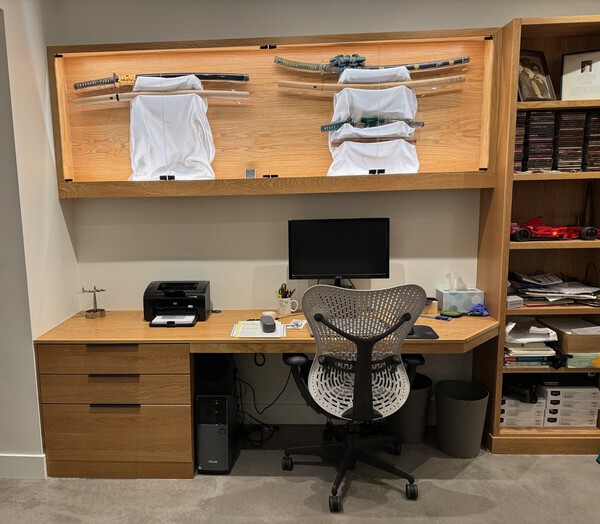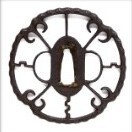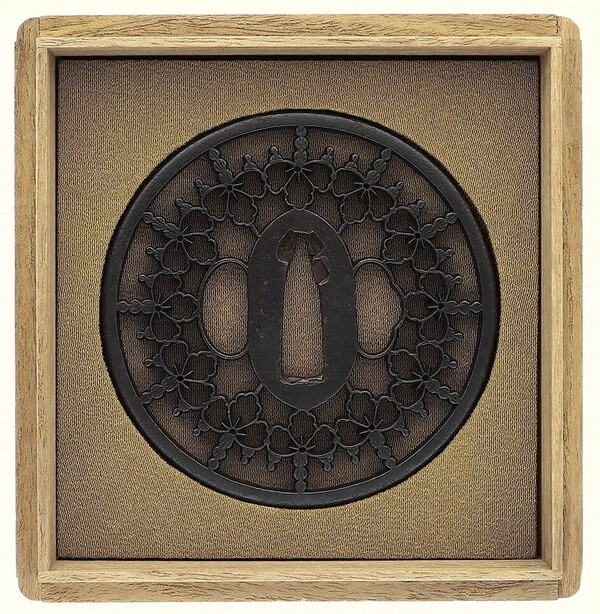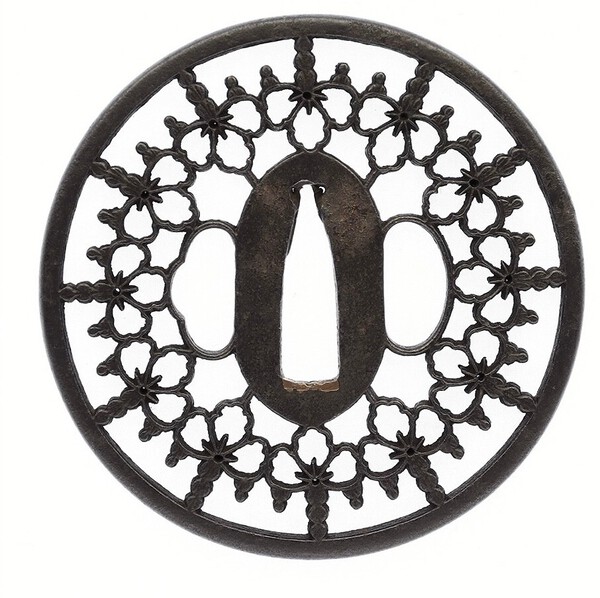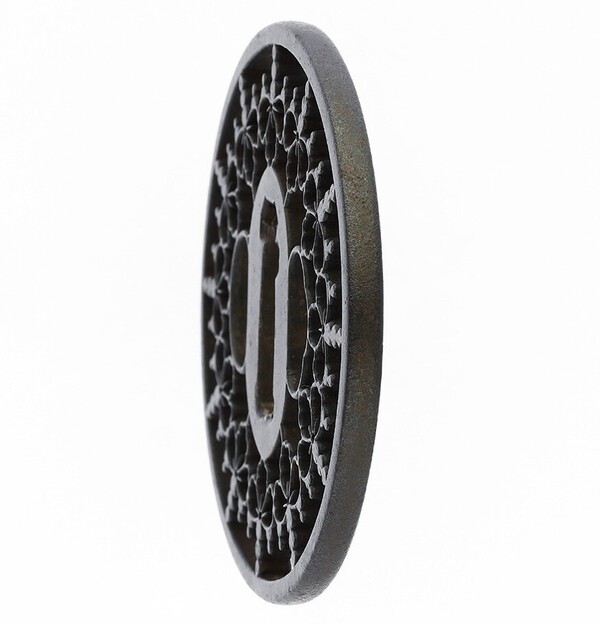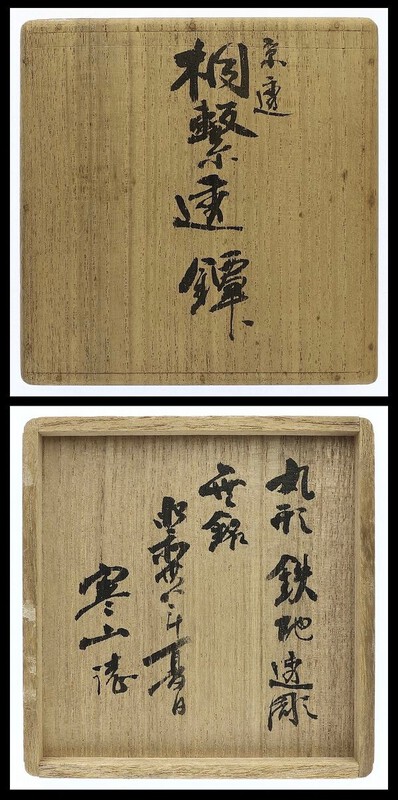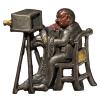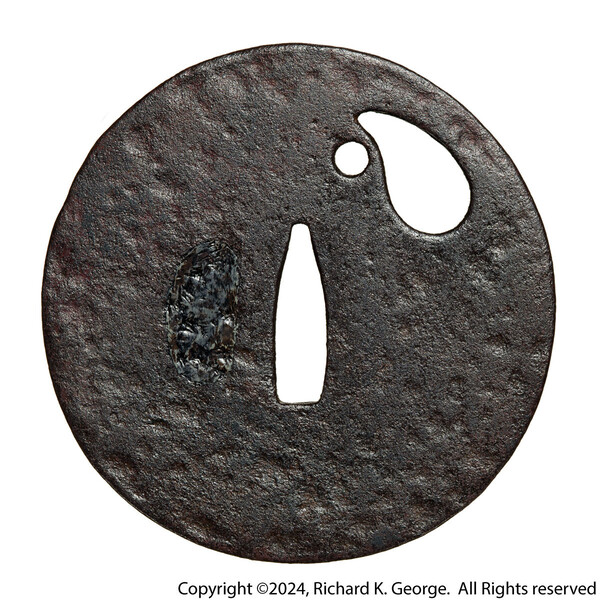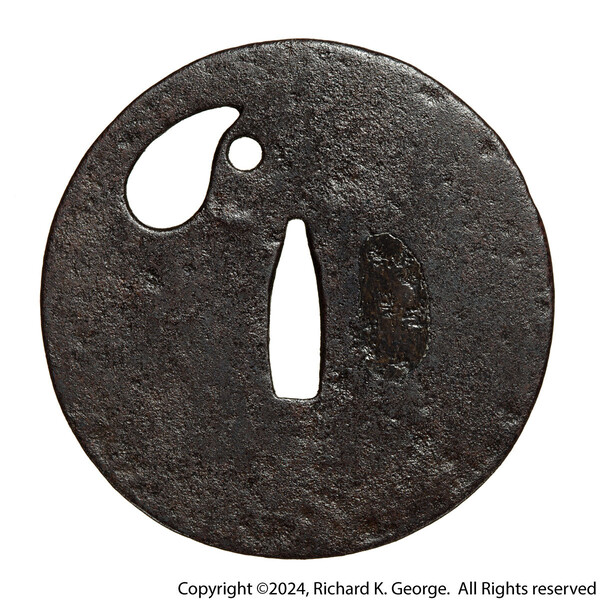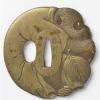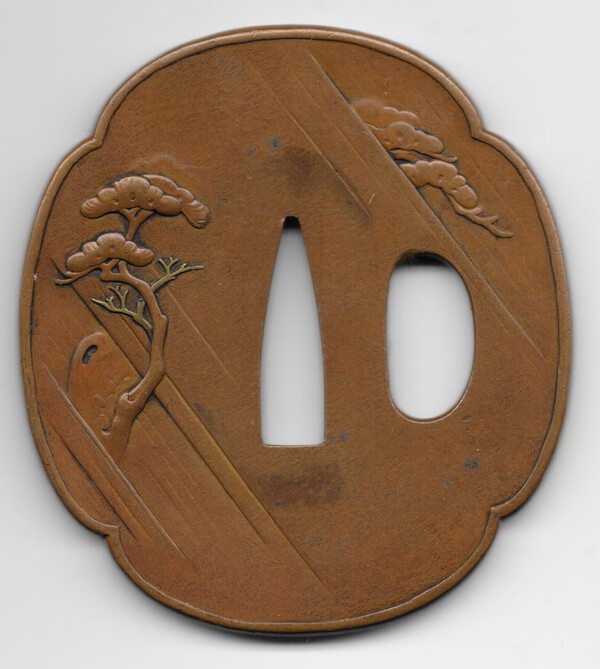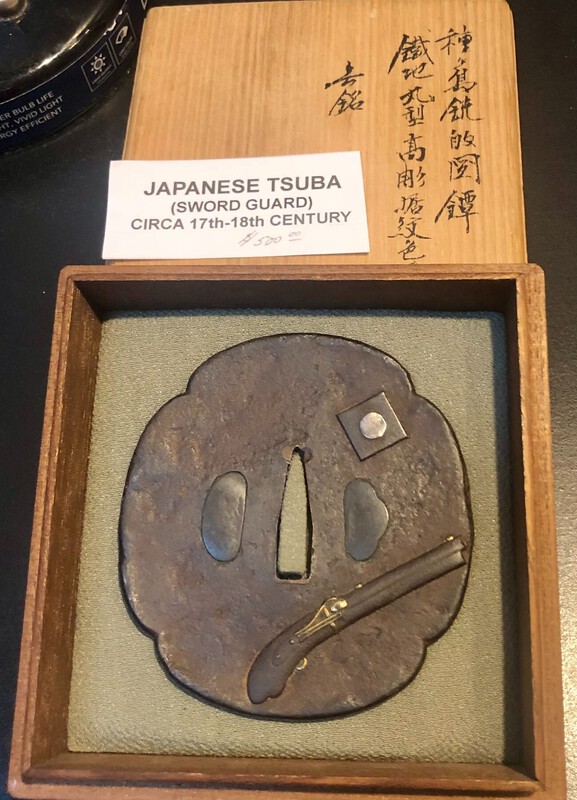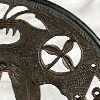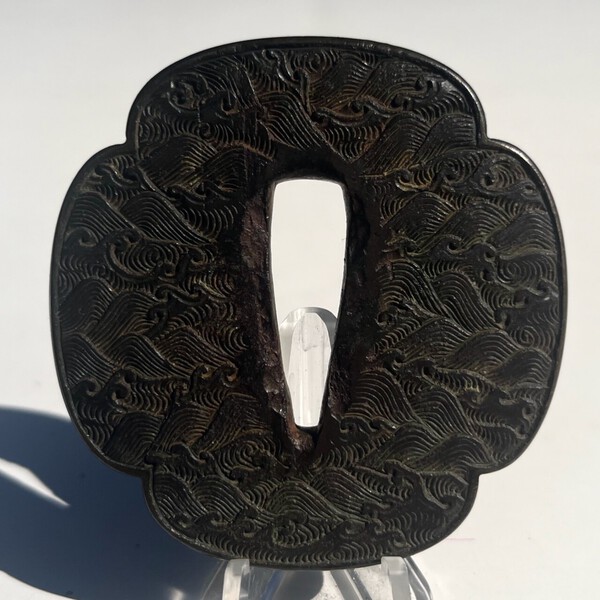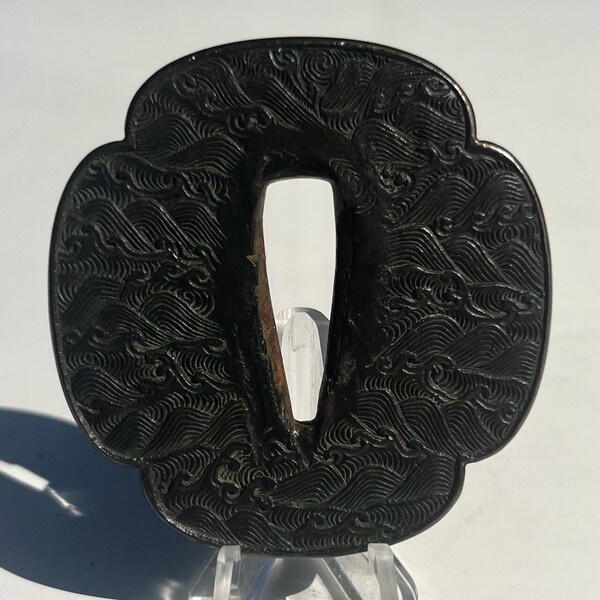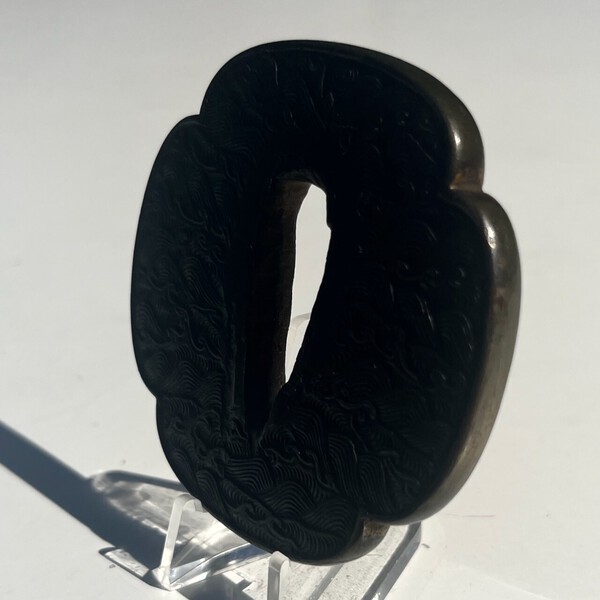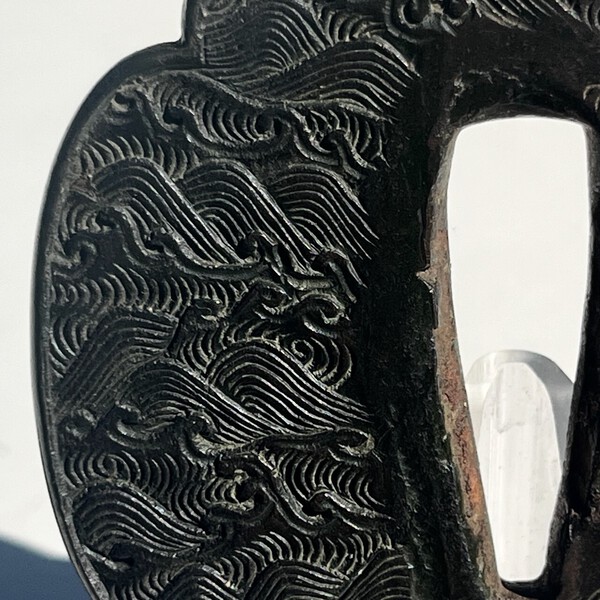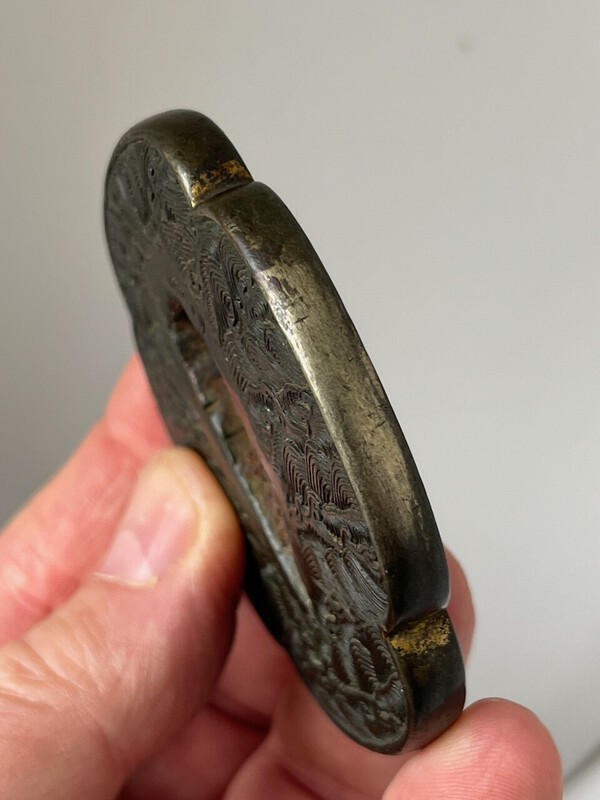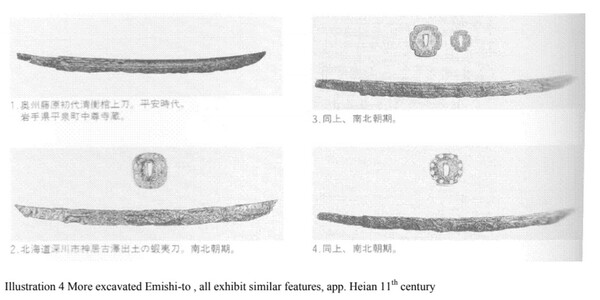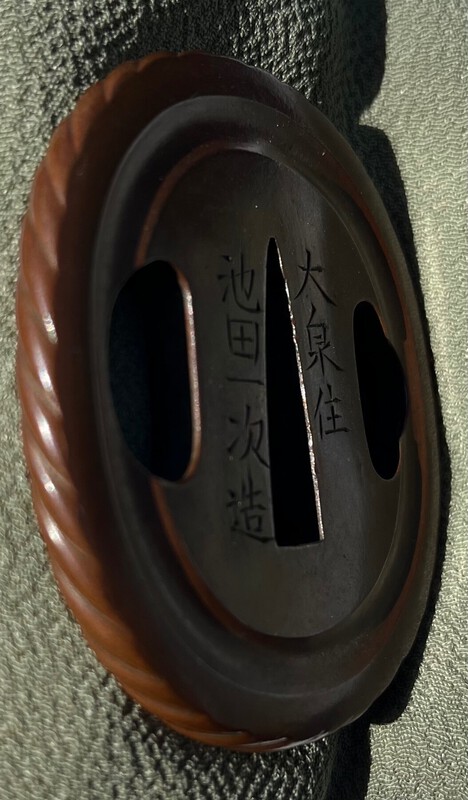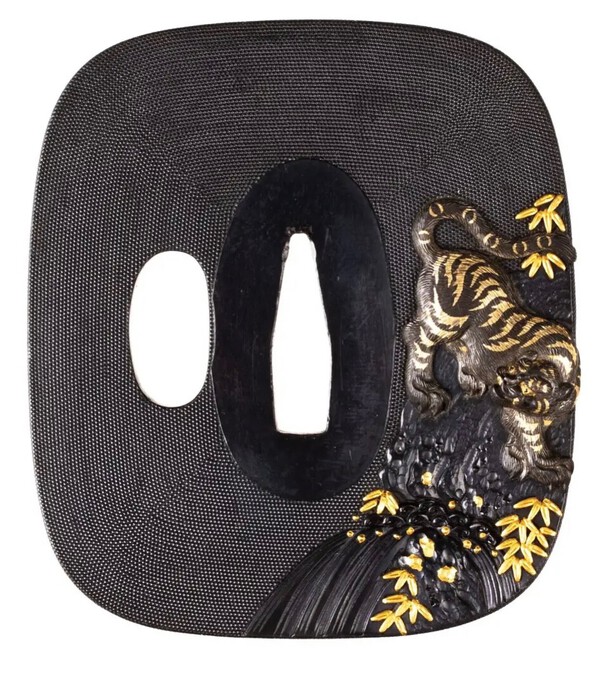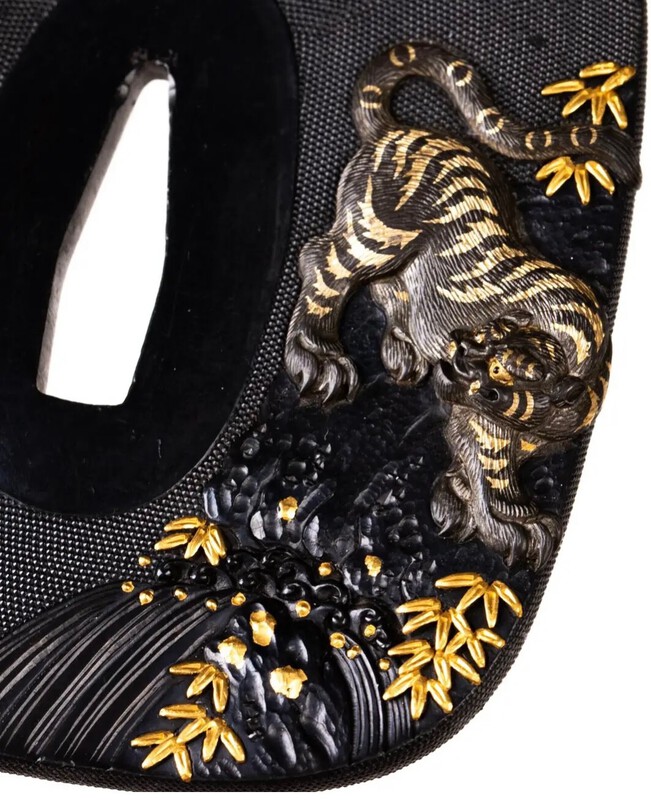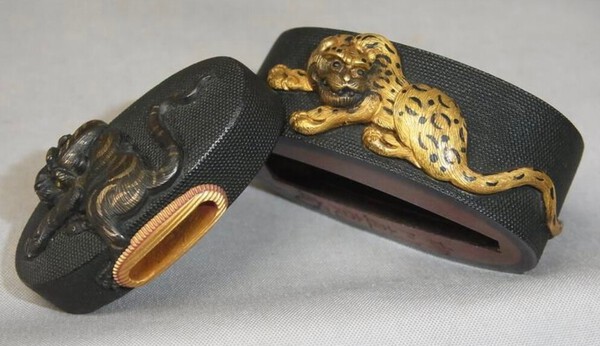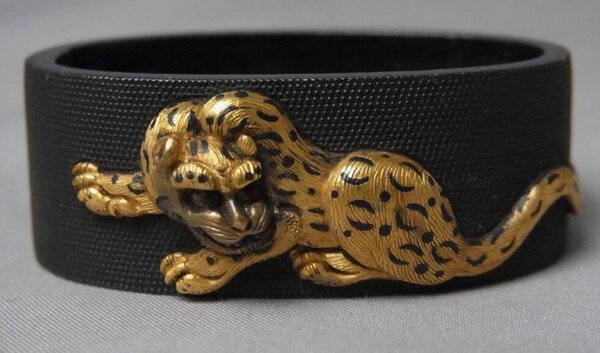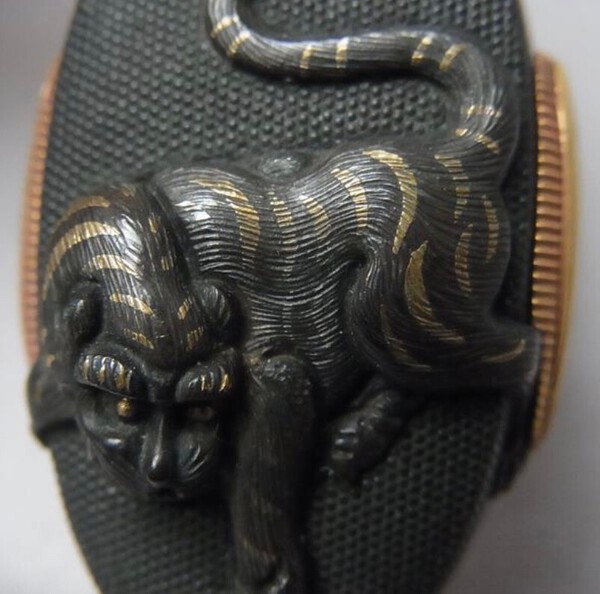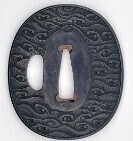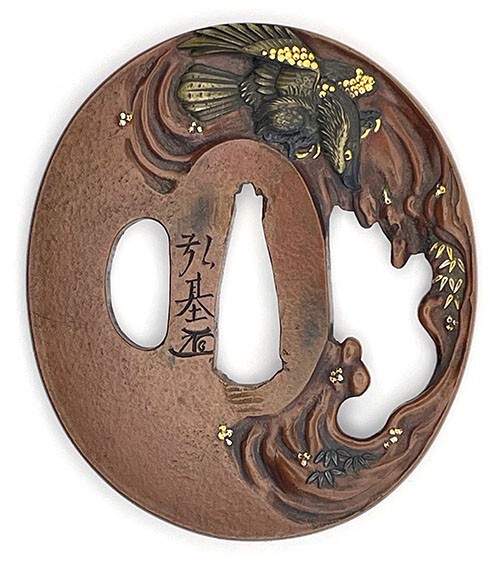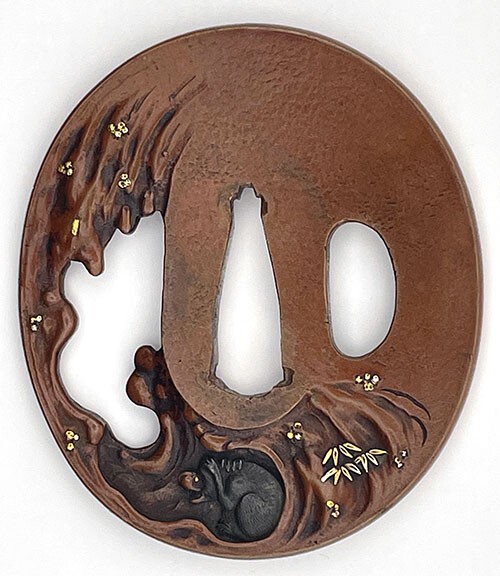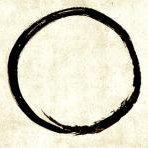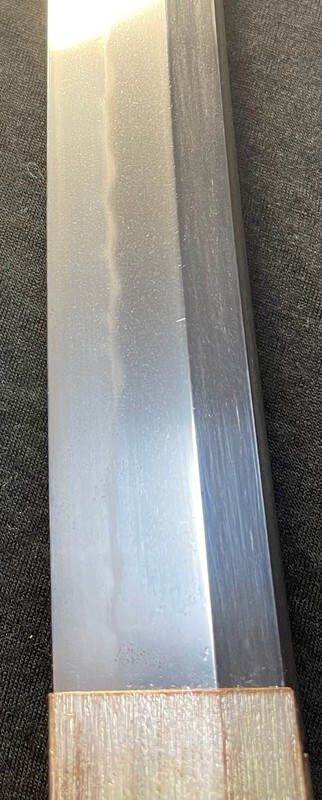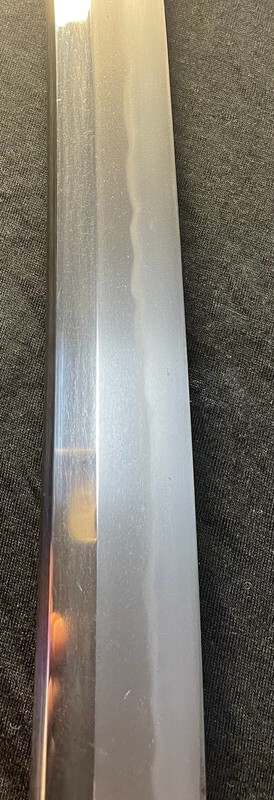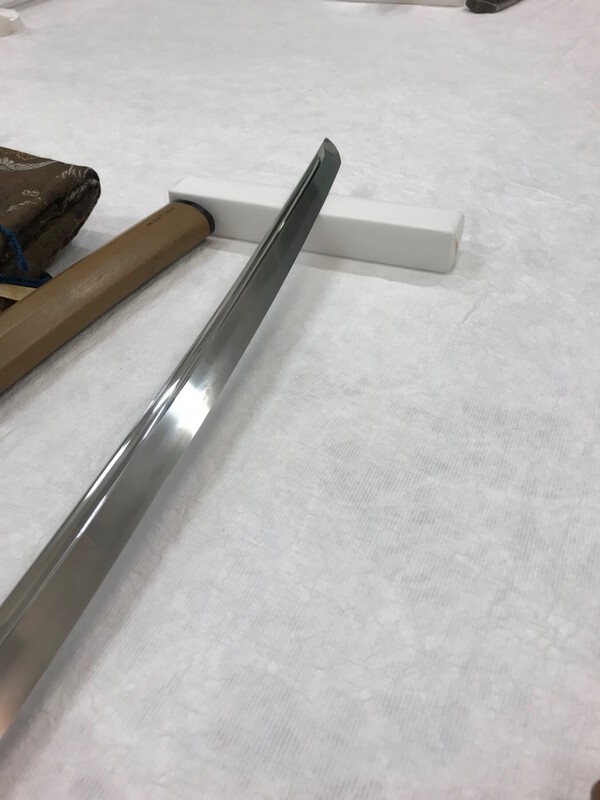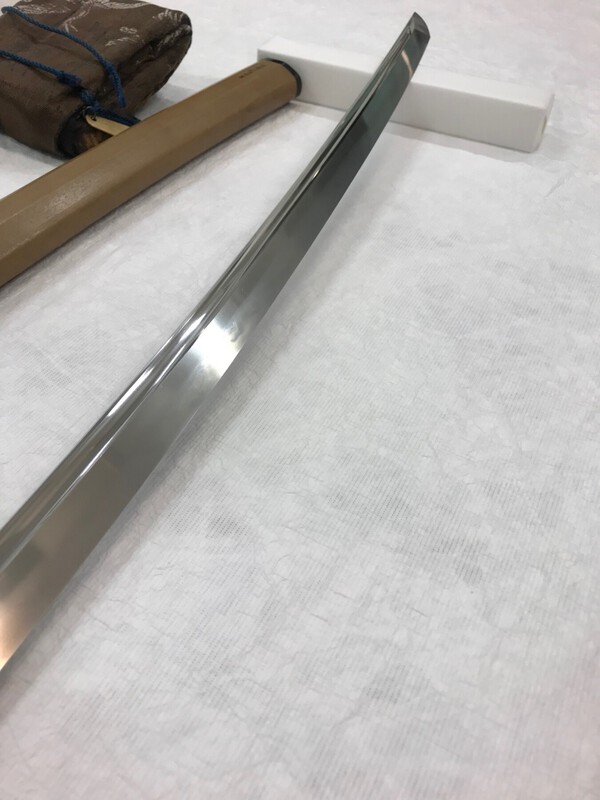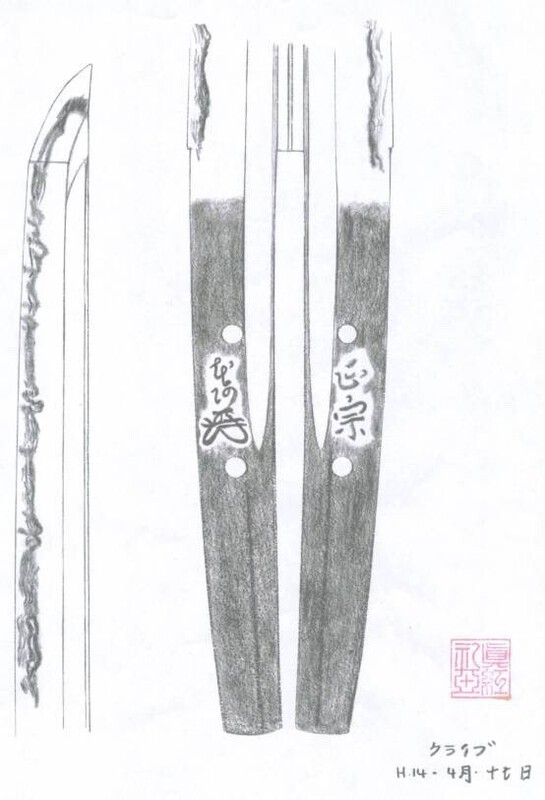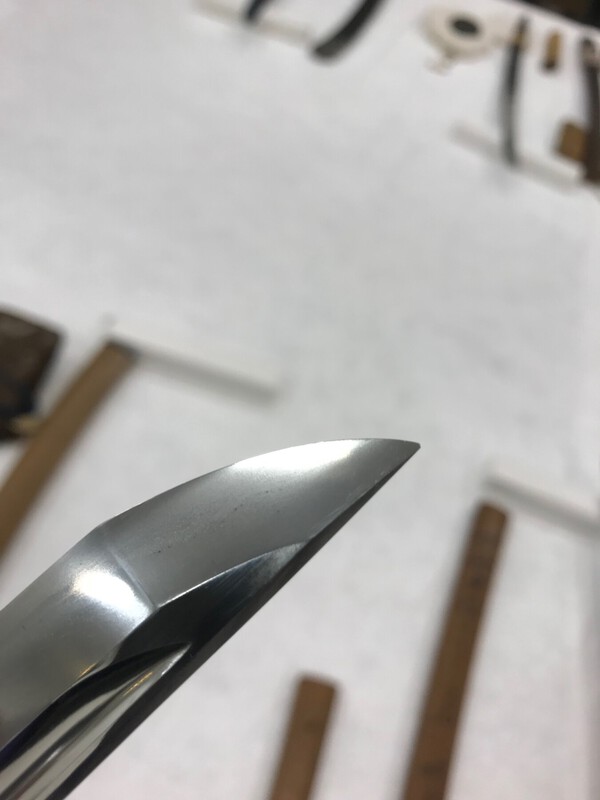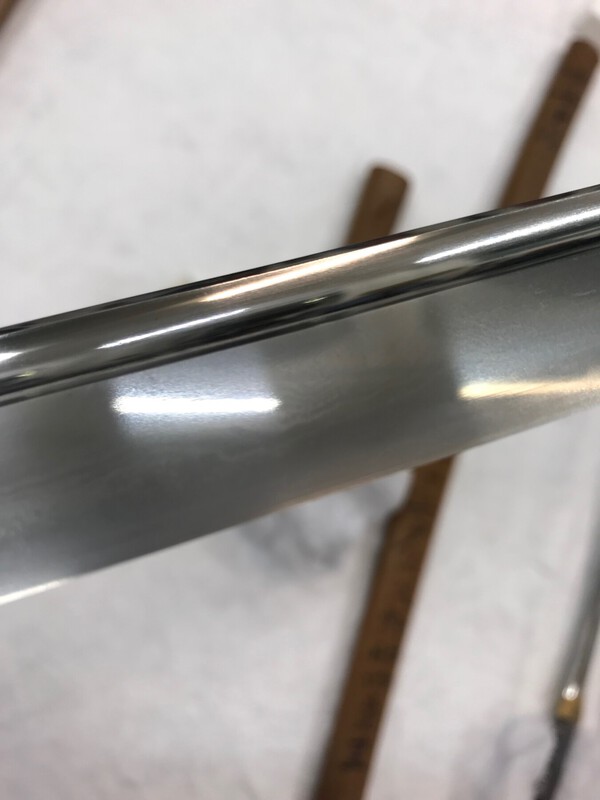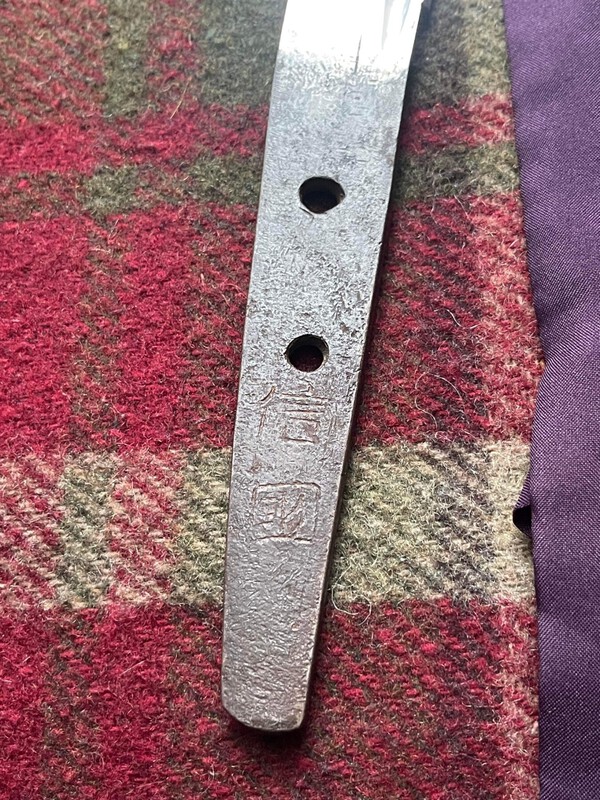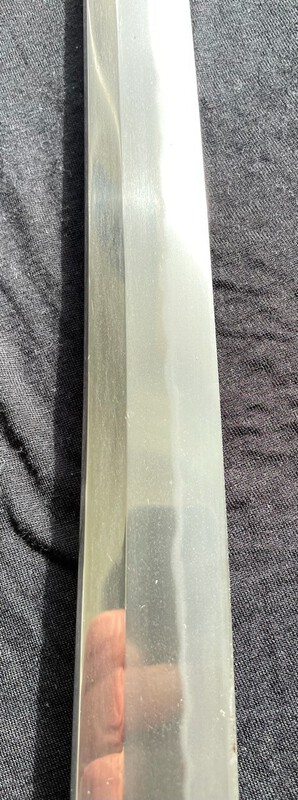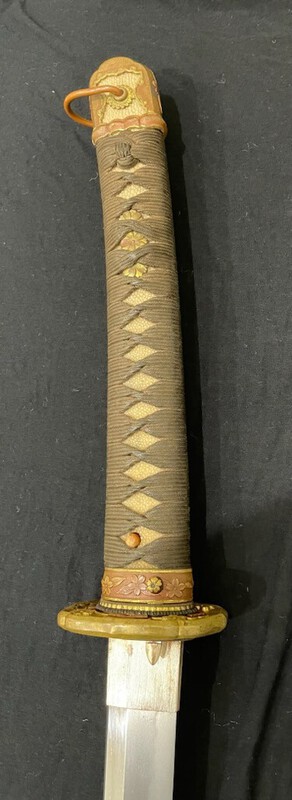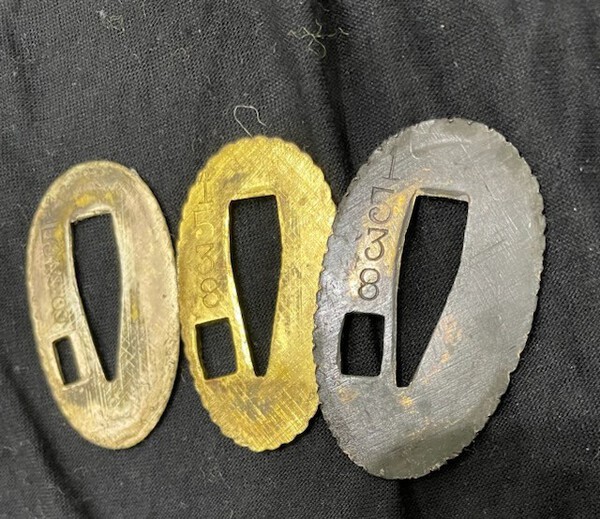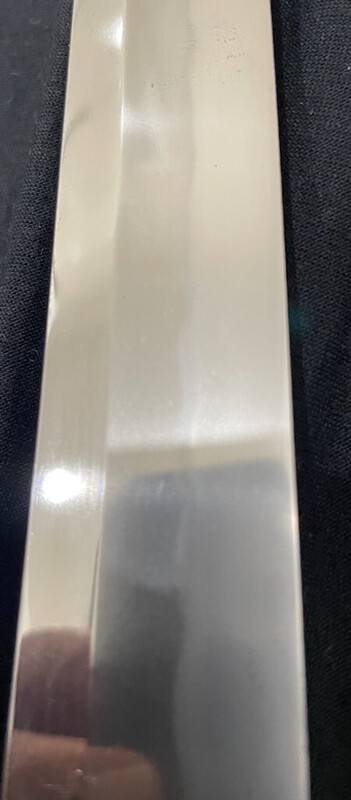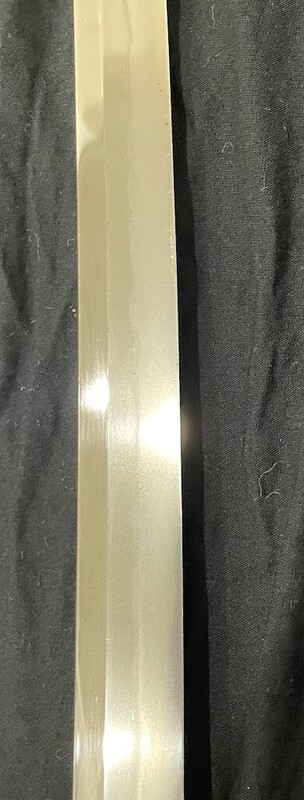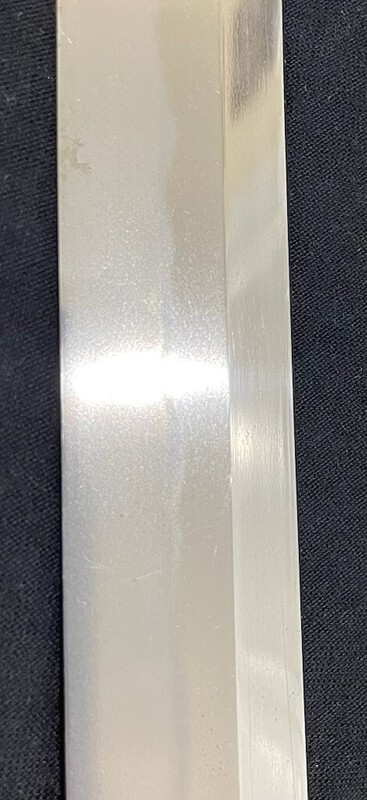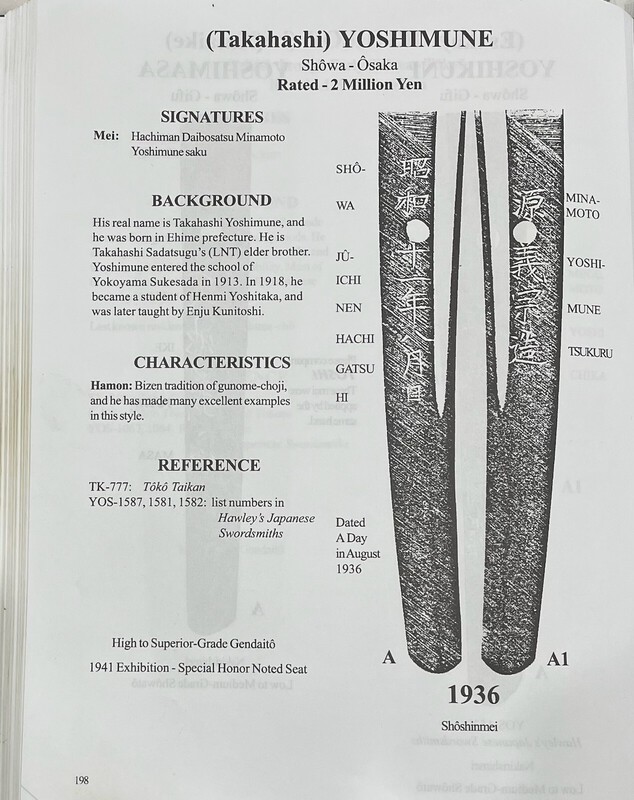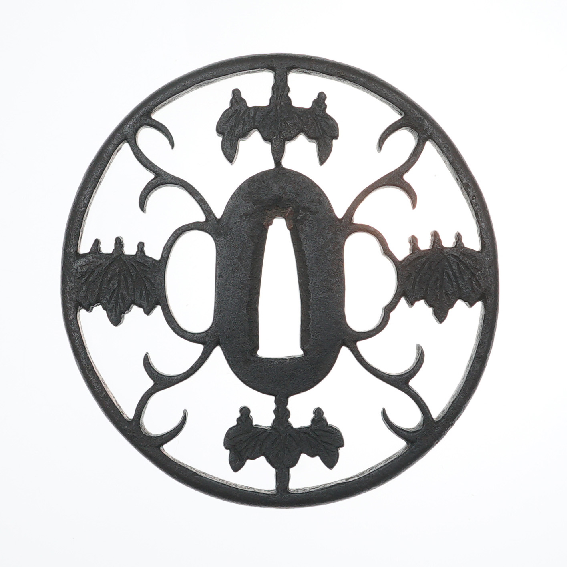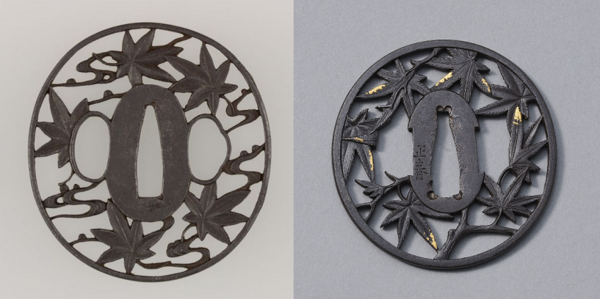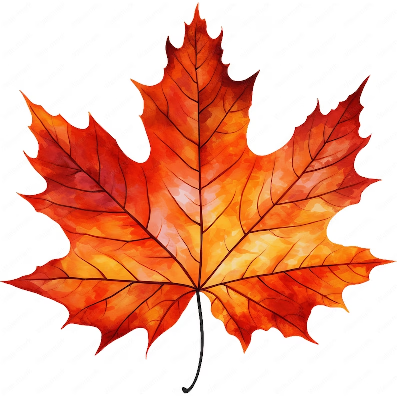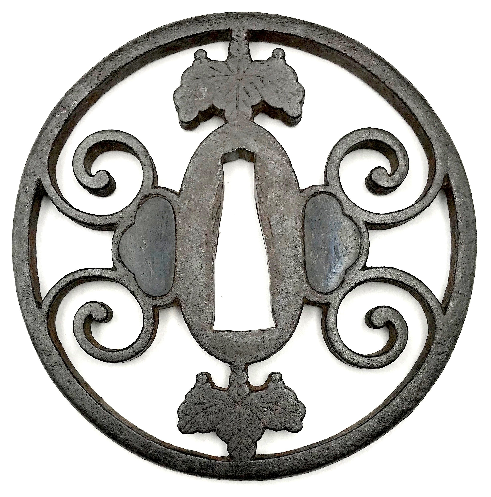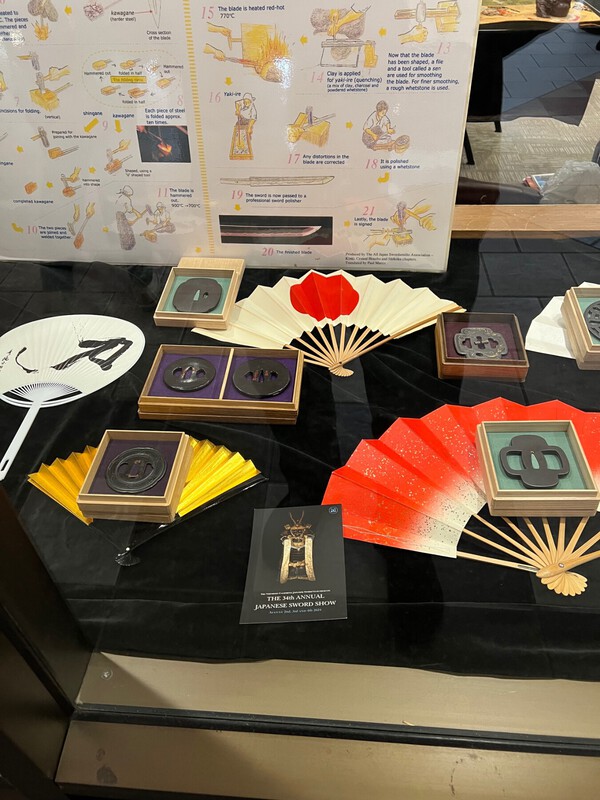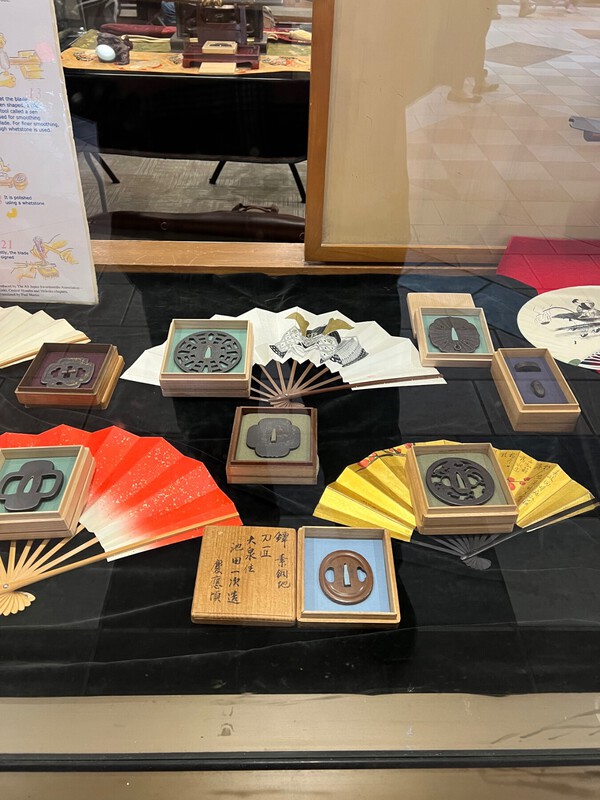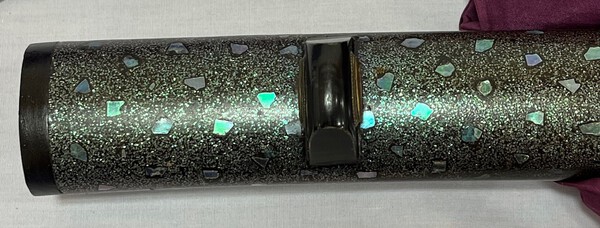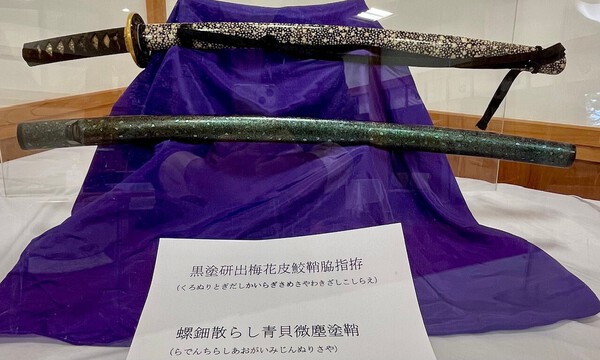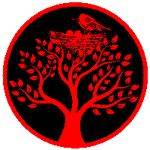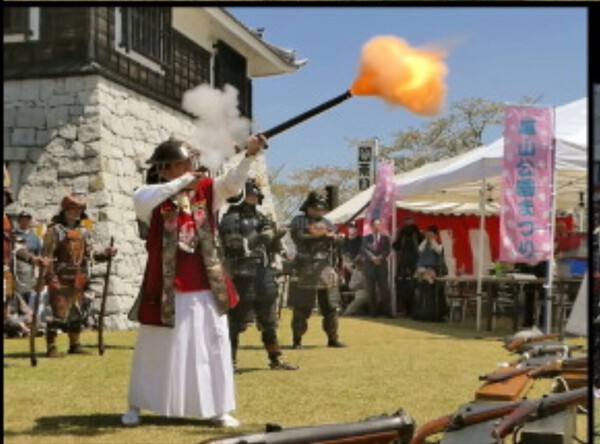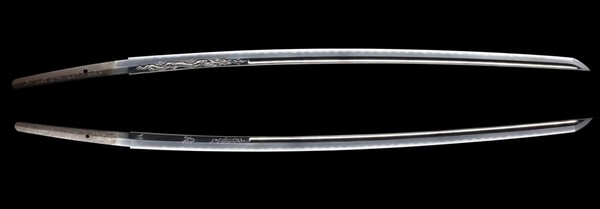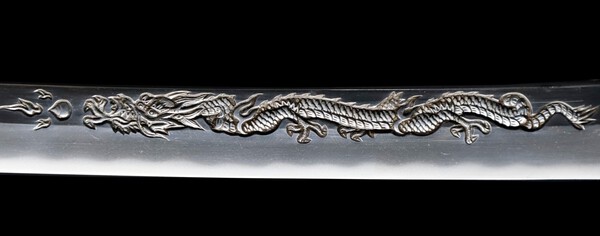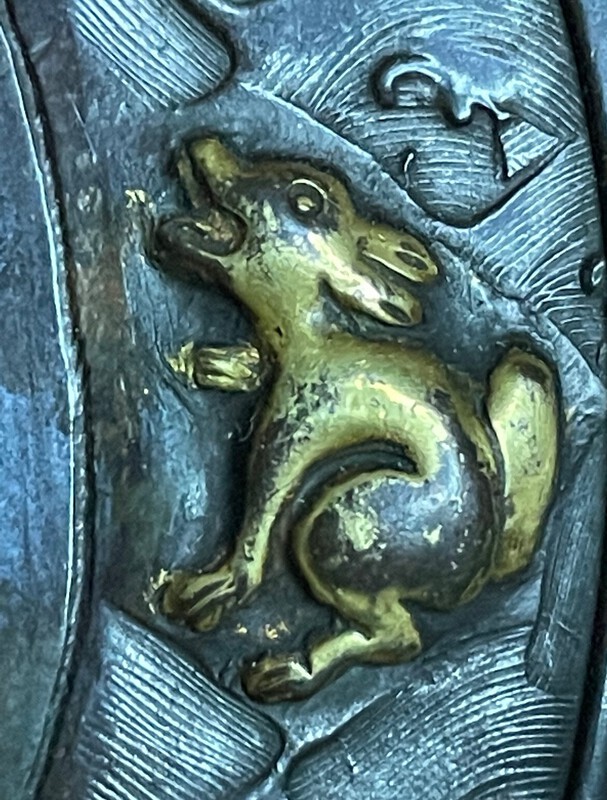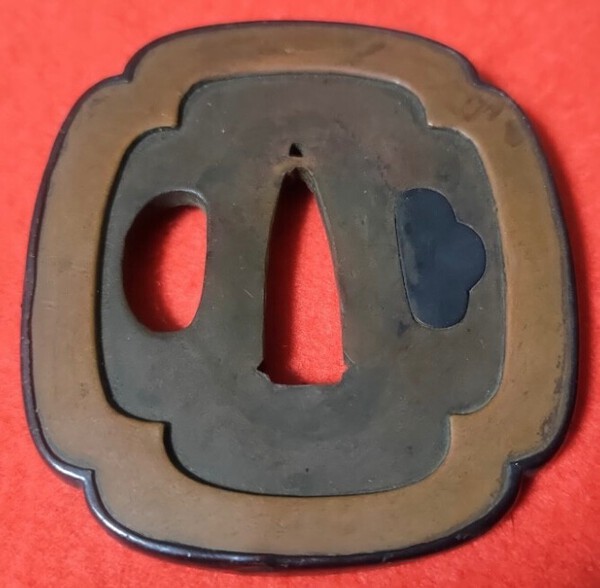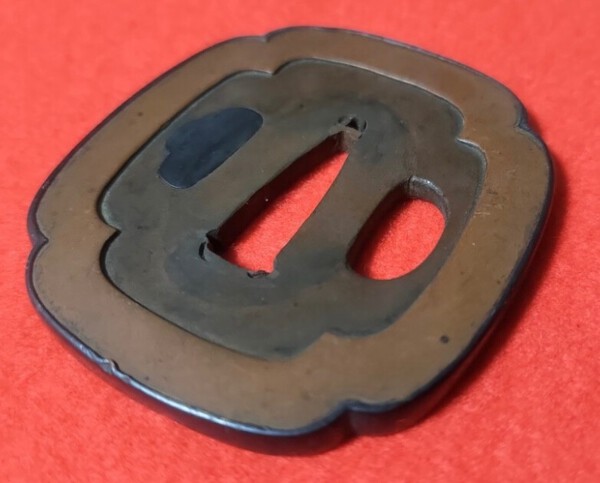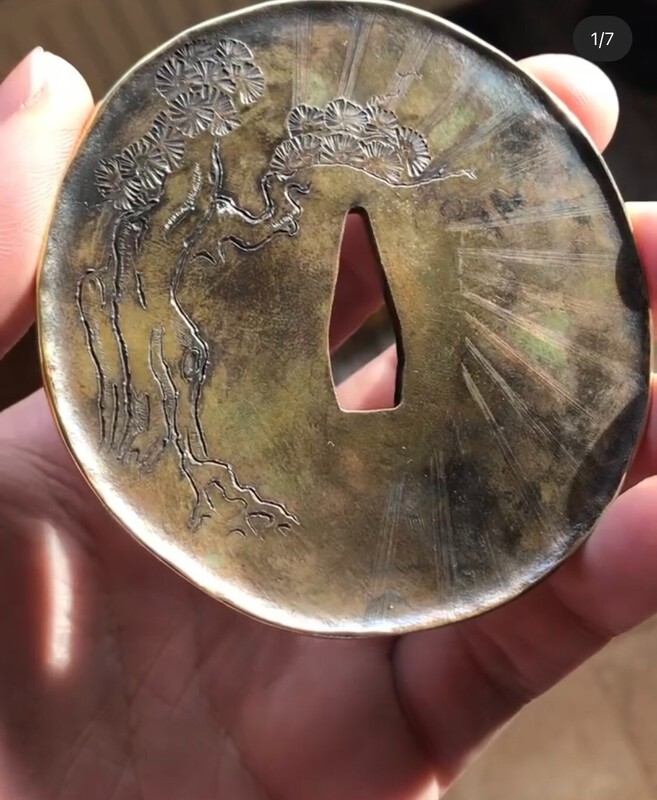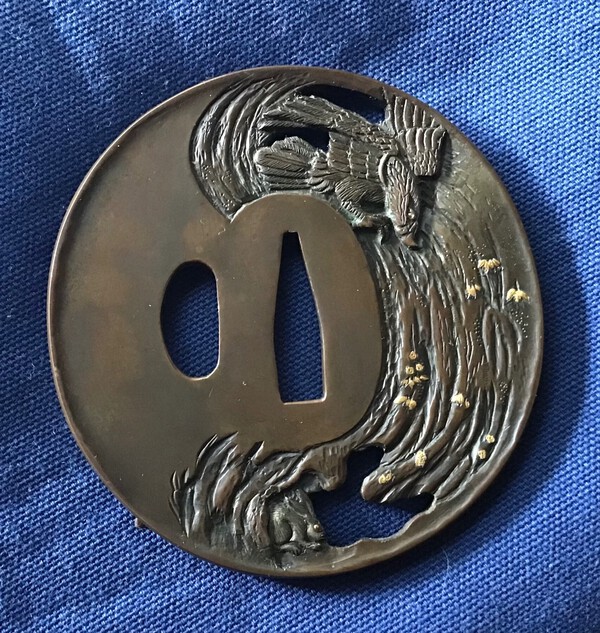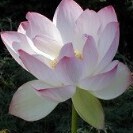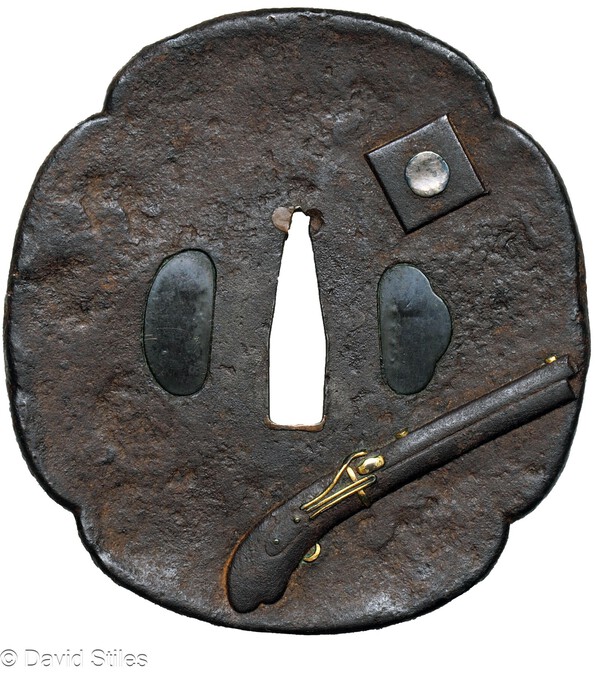Leaderboard
Popular Content
Showing content with the highest reputation since 03/25/2024 in all areas
-
O Suriage Tachi NBTHK Tokubetsu Hozon with attribution to Kokubunji Suke Kuni late kamakura Sayagaki by Mr Tonobe 69.2 cm He was originally from the Ichimonji kei in Bizen of which his Father was also a sword smith Sukekuni then went to the Bingo Mihara group to live and work Rated Jojo saku The Koshirae has menuki of the Hosokawa clan Many thanks to Mike Yamasaki for selling this to me17 points
-
15 points
-
I decided to build a display case for my small nihonto collection so that I could easily view them in my home office. To match the existing bookcases and desk, I built a box from 3/4-inch white oak plywood and 1x white oak for trim. The doors are tempered glass on minimalist pivot hinges. I also installed concealed LED lighting on the top and bottom to better highlight the contents. Finally, I cut out racks from MDF board that have satin covers to hide the unused spaces. It can accommodate 12 swords, so my collection has room to grow. I wanted to share because I’m really pleased with how it turned out. I am also curious if others here have unique ways they display their blades. If so, please share!14 points
-
14 points
-
I picked up this tsuba for my collection some time ago. Interesting Kyo- Sukashi Tsuba in very good condition. The Kyo-Sukashi-Tsuba is an open worked tsuba that was produced centered around Yamashiro Province (now Kyoto Prefecture). Feel free to discuss and comment on it. TSUBA - KYOSUKASHI 京透鐔 NBTHK Tokubetsu Hozon The Kyo-Sukashi-Tsuba is an open worked tsuba that was produced centered around Yamashiro Province (now Kyoto Prefecture). *Hakogaki written by Dr. Kanzan. KANZAN (KAN'ICHI) SATO was born in Yamagata Prefecture in 1907 and until his death in 1978 was regarded as one of Japan's foremost experts on the Japanese sword. He graduated from Kokugakuin University and worked in the National Treasures Section of the Ministry of Education and the Tokyo National Museum. He was the Executive Director of the NBTHK Society for the Preservation of Japanese Art Swords and the Deputy Director of the Sword Museum. His publications include works on Kotetsu and Higo metalworking and The Japanese Sword Book. Sayagaki: Often a sword's shirasaya can have an attribution written on it. Usually these days we see work by Mr. Tanobe Michihiro (Tanzan) of NBTHK, and his opinion is very highly regarded by collectors as one of the current top experts on Japanese swords.13 points
-
I haven't been able to shoot anything for over a year due to health issues - but I FINALLY got the studio cleared out, the various wind up stands in place, figured out how photoshop photoshop had screwed up my workflow (and workarounds), etc, and... Just for grins, here's a couple of images of a ko-tosho (or at least that is what the NBTHK thought it was, FWIW) I picked up off of yahoo!Japan not too long ago. I am not sure what the theme is, comments about what it might be are appreciated. The little beastie has a black coating - when I get some more time I will have to ascertain if it's black lacquer (I that might be what is going on) or if somebody put black wax or something on it. I need to pull down the microscope and fix that workflow next, thought that might take a while as I have a whole bunch of other fittings to try imaging. The piece measures74.2mm(H) X 73.3mm(W). It measures 2.9mm(max) at the seppa area and tapers to 2.3mm (max) at the mimi. rkg (Richard George)12 points
-
12 points
-
11 points
-
Gents, While it is probably easy to find tsuba which were mounted on tachi koshirae in the late Edo or Meiji period, this tsuba is a whole different story. It is a tachi or kodachi tuba, made of bronze, which has been gilded once, as can be seen thanks to some remnants. While the guard is small, it is heavy and its large nakago ana points at a substantial blade. A small tsuba mounted on a long blade has often been the custom in the turbulent Sengoku period. This tsuba is likely to date back to mid-Muromachi period, late 15th century. Measurements are: 6.7 x 6.3 x 0.6cm Nakago ana 3.15 high 0.9 wide Tsuba of this style are described by some collectors as "Northern", which I think is due to the fact that there have been tachi tsuba of this style excavated together with some Emishi-to in Hiraizumi, the capital of the Northern Fujiwara. Also, the much used (and abused) term Ezo is often applied to early tachi tsuba. I attach a pic from a Japanese magazine showing the excavated guards (and swords). In any case, this here is a wonderful tachi tsuba the type of which is very hard to find. It is small, so pne can speculate it was used on a kodachi or even a naginata (yes, naginata did have this type of tsuba). You can also find some tachi tsuba in this thread, with excellent photographs by Richard George (two of those tsuba were once in my collection, BTW): https://www.militaria.co.za/nmb/topic/38844-tachi-tsuba/ please scroll down to see the tachi tsuba. $1,650 incl. shipping to Europe and US. Wire transfer please (either $ to a bank in the US or € to a bank in the EU).11 points
-
That there are so many people wanting to authenticate their swords and tosogu is, in a way, a validation of the popularity of the current certification system. But it also exposes the limitations of the system. Its become a victim of its own popularity. There is a shortage of people who can act as competent judges, and the blame for this falls squarely on the NBTHK. One of their raisons d'etre is to educate the public about swords and fittings, and to this end they have study groups, seminars, publications, and a great deal of space in their sword museum is dedicated to lecture rooms (the three-story Sword Museum in Ryogoku, has two floors of study rooms and offices, and only one floor of exhibition space). They also know very well the looming problems of an ageing panel of judges, and the dwindling number of experts. So the failure of the NBTHK to educate and train a new and expanded panel of judges is a failure of the current management. Who is the next Tanobe, the next Honma Junji, the next Sato Kanzan? Why hasn't the NBTHK fostered the development of the necessary expertise? In a related note, the museum isn't a tremendous improvement on its previous incarnation (when it was located in Yoyogi). As I said, the swords are on one floor of the three-floor structure. The information cards are in Japanese, except for the the swordsmith name and the dates, which are listed in English as well, with multiple spelling errors. It feels very amateurish. There is a QR code you can scan to get English explanations, but the English explanations use machine translations, and, again, it leaves one feeling that not a lot of effort has been made to accommodate foreign visitors. I should also say that maybe 1/4th of the visitors were non-Japanese on the day I went. Anyway, the appraisal system is, I think, necessary and beneficial to the collecting community, but some things at the NBTHK need to change to ensure it stays relevant to the times and the current population of collectors.11 points
-
10 points
-
10 points
-
I am a fairly longtime member of NBTHK and I am supporting the organization as I believe they are doing many good things. However I have never sent anything to shinsa and for the forseeable future I wont at least in few upcoming years. This is bit astray from the original topic but as I feel the discussion is quite interesting. While I do believe the system that Japanese shinsa provide, however I believe for all of the organizations it is business. And while various organizations of course work as well as they can, there are several factors that affect their full capability. Here it should be noted that I have never been even close to a shinsa session and do not really know how they work. For NBTHK time seems to be a limiting factor. As some may know NBTHK has now put a maximum number of 1,600 blades for Hozon / Tokubetsu Hozon tōken shinsa. I do think the submission numbers were higher than that recently so they had to put a limit in order to manage deadlines. I am not priviledged enough to know how they process the swords and evaluate them but when you process 1,600 swords within a limited time, you cannot actually spend huge amount of time per one blade. I remember few years ago I discussed this a bit with Darcy and perhaps we tried to crank some numbers. I am not mathematically that good but I know that big number of items with limited time equals little time per each item. Here are some numbers for recent Jūyō shinsa that are of course previously already passed Tokubetsu Hozon, so items are already verified. Session 69 - Application period 2.10. - 4.10. and 828 blades were sent in. Final judging for swords 1.11. and 56 blades passed. Session 68 - Application period 3.10. - 5.10. and 817 blades were sent in. Final judging for swords 2.11. and 66 blades passed. Session 67 - Application period 4.10. - 6.10. and 852 blades were sent in. Final judging for swords 29.10. and 111 blades passed. I do believe NBTHK probably might have one of the largest reference collections. Plus I believe they do keep a record of all issued certificates but I believe they would classify them by number as that will make it easiest to search specific certificate numbers. As that is the most logical way to keep them. I would also believe that access to NBTHK certificate data is to staff only. However with the reference materials I can focus on the second issue time vs. reference materials. As we all know there are some common references where we usually check the signatures. However in order to make a reference book effective you can only feature X number of items per specific smith. When working with time restraints there is a limit how much research you can do. When you have to go through hundreds of signatures within one month it gets bit limited compared to researching one specific signature for multiple months. I take Bizen Nagamitsu (長光) here as an example. Fujishiro - 8 reference mei Sesko Meikan - 11 reference mei In my personal references I have 207 different (verified by experts) signed items by Nagamitsu The reference books will create a good general base for signatures but there are possibilities not featured in common references. Of course in general you don't have to dig up all the possible reference signatures of the smith but sometimes few in common references might not be enough. And the final thought on my mind that must be considered is expert knowledge. I have never attended NBTHK meeting in Japan but the times in Europe I have been around senior NBTHK-EB members I have been astonished by their kantei skill and knowledge when quickly viewing items. The kantei sessions in both years at Utrecht were really nice to see how much details people pick up in extremely short viewing. I will always remember taking my own tachi to NBTHK Scandinavia meeting where a senior member told me fine details after a minute or so viewing the sword that I did not know about my own sword I had owned for quite a while... I think that my point is to encourage doing research and having fun doing it but at the same time there is a reason why NTHK or NBTHK shinsa team would have certain members, they are experts.10 points
-
9 points
-
Forgive the chatty nature of this update. Some things need to be written down to get one's head in order. 1. Where is our mentor Stephen? He went lurker for a while and then... silent...(?) 2. This Saturday I am hoping to get the little Nami no Hira back from the Togi-Shi. 3. This Sunday we have the third black powder event of this year up at Susai Castle to the east. Yesterday I cleaned the guns after Sunday's event and prepared them for this next one, and today I have been doing some running repairs on armo(u)r and guns. Like fishing nets, your equipment on the battlefield needs constant little adjustments or you're in trouble. For example, my tachi often gets knocked out of the saya by the weight of the pistol holster as I'm performing, and having tried everything I have resorted to tying it shut with string. Looks bad at close quarters, but hanging half out looks a whole lot worse. Then my matchcord keeps falling out of the serpentine as the hammer falls, causing misfires. Naoe Kanetsugu said around 1600 that you should have a matchcord that fits your gun, not too thin and not too fat. I think my problem is that I cleaned the inside of the serpentine pinch flaps too enthusiastically, leaving them smooth. So, fiendishly clever I know, but I have applied rubberized glue to the inside of the flaps. Cannot be seen, but it increases grip and pinch, reducing the inner diameter of the flaps inner side walls. (Why not squeeze them together slightly? With shinchu you have to be careful bending them or you could easily introduce cracks into the brass.) 4. On Children's Day (5/5) we have a blackpowder event at a big shrine near here. But they have also requested a static display of interesting artefacts, and the son of the city mayor also needs to be dressed up in full armo(u)r, apparently, which means sourcing a complete spare set of everything for him. Ashigaru light armo(u)r won't do. Our organizer is in hospital, so I have a nasty feeling that he is expecting me to arrange all this, on top of getting myself ready to perform. Besides, what theme should this display have? How many other people has he requested artefacts from? Aaaarrrggghhhh................ This will need focus and close cooperation.9 points
-
9 points
-
9 points
-
Like many things these days, there is a bit of Shrink-flation at the NBTHK. Ideally, limiting the number means a bit return to more knowledgeable response of shinsa of years past. Realistically, it is just another hurdle. My opinion of NBTHK papers has slid the past decade. Now I check the dates of the papers and handicap the opinion. True story: [1] a very good condition iron tsuba that I thought was nidai Kanshiro. Off to NBTHK shinsa and the results are "Higo". Well, that is useless. As a friend said, "Use if to line a bird cage or the bottom of a cat box?" [2] I sold the tsuba. New owner put it through NTHK-NPO shinsa. They bounced it as "modern". Buyer asked me what I wanted to do? I said. "oh, I forgot it had NBTHK Hozon papers. You want them or want to return the tsuba?" [3] He kept the tsuba and papers. Amidst a divorce, he sold the tsuba. It pops up in Japan with a dealer, with more recent papers NBTHK papers to Kanshiro. [4] An authority shows it to me and says "shodai Kanshiro" So, what do I make of all that? Paper game, even more fiat than most currencies nowadays. Do I still paper? Kinda, sorta? Is it worth it? No, not really. I get a lot of Horyu on anything big names I send in to the NBTHK. I then have to wait 6 months more and resubmit. So far about a 100% success rate on the second try, but it is a lot of hassle and agent expense to have to submit twice for what should be relatively easy match workmanship and signature to books.9 points
-
It’s the result of overestimation of papers. Today it seems every piece must have a certificate. In my eyes the necessity of those is in question anyway not to mention discussions about the outcome. The collectors should learn again to estimate the significance by own examination and in discussion with other collectors instead sticking to a paper. Best, Florian9 points
-
9 points
-
Ko-Tosho for Sale -Ubu, late Nambokuchu to early Muromachi- $800 $775 8.07cm x 7.7cm (3.9mm seppa dai vs 3.7mm) Oldest iron tsuba I have ever owned. Very nice seppa sukuri wear on the seppa dai, from a long time mounting. Excellent condition, color of an old sword nakago, and a sea of age evident when you view it in different lighting. Fitted raised box too. Curran8 points
-
Michael asked for updates, but I've been run off my feet since Saturday. The spirit is willing but the body is weak. Saturday morning to Shikoku. Saturday evening NBTHK local meeting. Displayed some more tsuba. Sunday all day up in Susai Castle for their cherry blossom festival. Some blossoms remaining among the green leaf shoots, petals falling like snow. Former Prefectural Governor Mr Ishii Masahiro, LDP House of Counsellors representative was there with his wife to watch us. I noticed he placed his fingers in his ears as the guns got bigger and louder. Back home I dragged all my stuff inside to discover my wife had piled the front hall with heavy boxes. "Help me load the car", she said, disappearing somewhere, so I ended up doing the whole load. Every bone in the old body aches. Monday. Up early for the hour's drive to the antiques fair in Ako, then back to meet someone for lunch before returning home after more than three hours on the road in order to clean the waiting guns at last. No rest for the wicked! PS Some photos and a video from the bridge at Susai last week have finally emerged. PPS Last month I finally managed to acquire a Sendai long gun, and on Saturday there was a quick window to get a fabled Satsuma gun, which I grabbed. These are both as rare as hen's teeth, in these parts anyway. Why have they suddenly appeared when everyone was complaining there was nothing on the market? This spring has been a mega expensive time for me though... but these chances do not come up like this.8 points
-
Found this Tanegashima Island video from last year celebrating the first arrival of guns there 480 years ago, and their relationship with Portugal. In the footage at 2:18 I spotted a shot of me in armo(u)r from 2008! See the gun troop with Ikeda Bizen-Cho butterfly Kamon, which is our lot when we visited the island for a national event 16 years ago.8 points
-
Big Jimmy in Antarctica, my name is in my signature:) By the way, why are you asking about that blade and how did you come across it? It is not well publicised or too widely known…. It is a very good Soshu den sword with very interesting activities and promise. It could be a Shizu or something of that ilk or even Masamune depending on polish. It bears a Kojo (one of most reputed Honami judges) kinzogan, but that kinzogan is a bit different from the typical Kojo kinzogan. To paraphrase Tanobe sensei, “it needs further study”. As far as I know, the sword has not been to Japan for shinsa. From our old records: Nagasa: 72.0 cm Moto-haba: 3.1 cm Saki-haba: 2.0 cm Sugata: Hon-zukuri, a graceful tori-zori, chu-kissaki, mitsu-mune. Jihada: A prominent and flowing itame-hada with mokume and abundant ji-nie forming chikei. Hamon: Fine nie-deki, notare-midare with some gunome like inclusions, profuse sunagaeshi which spills over into the ji in places and kinsuji. The boshi is slightly midare-komi with very little kaeri. Horimono: A bo-hi on both sides that finishes in the nakago between the two mekugi-ana. Nakago: Suriage by probably 3 or 4 cm and machi-okuri, 2 mekugi-ana. Kiri-jiri, faint kiri yasurime are just visible and the bo-hi finishes in a pointed end. There is kin-zogan mei on the sashi-omote MASAMUNE and on the sashi-ura HON-A with kao [KOJO]. This sword has a robust sugata that retains its elegance in spite of the suriage. Both the hamon and the jihada reflect the nie dominant hataraki, which together with the large itame- mokume- hada and mitsu- mune, associate the sword with old Soshu- den. The shape is both graceful and strong whilst the bo- hi provide the sword with a balance that makes it very easy to handle. It is in fine condition and all details are easy to see. Previously it was the property of Alfred Dobree, an active collector in the early 20th century, who donated it to the Victoria & Albert Museum in London.8 points
-
8 points
-
Wow, Thomas! What a page of habaki!!! We could practically shut this thread down and just send people there from now on, Ha! My favorite on the page:8 points
-
Hi Mark, Wood of the shirasaya shrinks and expands with changes in humidity; the habaki doesn't. The blade should be inserted far enough that the habaki is comfortable, gripping but not forced. Too far in and the saya can split and/or the foil on a habaki can rip. The gap is not a problem. As for protection from dust, that is why we keep our swords in bags. Grey8 points
-
I would not paper anything that you have a good idea of the provenance of. I have learned over the last few years of my study that papers are just educated guesses on the attribution of the piece and are relatively worthless as a value added addition to an item. Many times, different appraisers provide different attributions, thusly nullifying the effort and burning your $$. An example below. I know this is Owari Kinko. If i send it to get papered, it will come back and Tokubetsu Hozon to Owari Kinko. Now the question is, why would i spend $250 to paper it?8 points
-
8 points
-
This sword could live just as happily live in the Nihonto section as well as the Military. A May 1941 (Takahashi) YOSHIMUNE, in the less common aluminium saya, All the fittings are matching numbered "1538", indicating an original complete sword. His lineage as a swordsmith is without question, his brother SADATSUGU was a "Living National Treasure". This BIZEN tradition sword has a nice hamon and hada, the photos do it no justice. The MEI translates to "The God of war, Minamoto YOSHIMUNE made this". I share this sword because I spent years trying to find a top example of his work as I think he was one of the top Gendai sword makers. I acknowledge using pages from Slough.8 points
-
I think the plant design is a little ambiguous. I can see the resemblance to a Maple leaf plant motif but it also has characteristics of Kiri? The example below from the Varshavsky collection is not a million miles away from your tsuba design, the Kiri motif is just "pulled" further out of the rim and has the usual central top of the leaf which is missing on the one you have. [I have no idea why] " The Kiri (桐) pattern is generally composed of three standing straight inflorescences and three leaves." https://www.samuraimuseum.jp/shop/episode-5-design-plant②/ https://varshavskyco...collection/tsu-0259/ “Gosan no Kiri” once was used by royal families or leaders for their emblems, and it’s being used even ordinary people today as their family crests. Arabesque designs are put between “Gosan no Kiri” patterns and engraved by openwork. Arabesque pattern represents prosperity and longevity. Maples would tend to have more tips to the leaves [depends on each species]7 points
-
7 points
-
One good thing about Japan is you can fly over, wander around and step back into this kind of atmosphere, forgetting all about the troubles in other parts of the globe. Last weekend was another busy one, with a sword display up in the grounds of Achi Jinja on Tsurugatayama in Kurashiki. Always a pleasure to go back there as I once lived at the foot of that hill. The Jinja and surrounding walks are lovely at any time of year. During the day on Saturday the polisher handed me back the little Nami-no-Hira tanto. One or two spots of rust were deeper than he had thought so he had been forced to use a coarser level of stone, he said. That evening I had a message to say that the Satsuma long gun had been repaired, so sneaking out of the house I did a two-hour round trip to pick it up. The snapping lock now works again, at last, and he had managed to extract the stuck Bisen breech screw. The folding trigger turns out to be a strange affair that somehow disengages from the serpentine lock when in the folded position. I wonder if there was a further external soft cover that held it folded, protecting the exposed trigger for travelling? Now I must create a karuka ramrod for it. Luckily someone gave me a length of red oak, (the proper stuff) which I may attempt to whittle down into a suitable shape.7 points
-
7 points
-
7 points
-
7 points
-
7 points
-
These TAGANE stamps in the shape of a star or a flower (more likely) are not uncommon and often seen as decoration in filled-in HITSU-ANA on TSUBA. In your case, they were obviously used to expand the copper SEKIGANE to secure it more tightly.7 points
-
7 points
-
八幡公所佩貫級刀製 – Imitated kankyuto which was worn by Hachimanko 八幡公 (Hachimanko) means 源義家 (Minamoto no Yoshi’ie). Ref. Minamoto no Yoshiie - Wikipedia7 points
-
7 points
-
7 points
-
7 points
-
7 points
-
To comment on Dale’s question re alloys….I think the alloy “formulas” were very variable and I’d bet a lot of experimentation went on especially in late Edo onwards. Add to that patination techniques (natural and artificial) and looks can deceive. There is another alloy that looks almost exactly like Shakudo but isn’t. I know we are talking copper here but when shibuichi can vary from olive green to pale grey I’m sure other alloys were “played with”. This large (and very late) katana tsuba landed here a few months ago and I was certain it was copper but after what Piers says about shinchu I’m not so sure. In Meiji metalwork when copper is used it patinates to a very dark red (difficult to describe).7 points
-
Just a quick word of warning to anyone out there who might not be aware. Recently I was admiring some 'copper' tsuba in the magnificent tsuba exhibition at Osafune Sword Museum. "Those are shinchu" (a kind of brass), the guide said. "Over the centuries they turn to a reddish copper colo(u)r, but that is the resultant patina, irreplaceable."7 points
-
7 points
-
Perhaps the problem isn't the NBTHK limiting submissions, but rather too many people chasing papers. Desire is the cause of suffering.7 points
-
Thanks Brian, I post the occasional sword to share my enjoyment whilst I have it in my care, until the next generation can acquire and preserve it. I know iPhone photos are not always the best way to show off a sword's attributes, but I do my best. If I have ever had a question about a sword, I do it by PM, in a polite way. There are many folk out there that have an interest in Japanese military swords and GENDAI, and not a day passes that I am not on the phone, email or SMS to one. And thanks to "whatsapp" many overseas (hi Bruce!). For many collectors on this forum, the Military section is their first go-to area. Keep it positive, polite and constructive.7 points
-
I took some better photos of this tsuba over the weekend for update of my website (www.tsubaotaku.com) next month. Here is a low-resolution copy of one of the photos small enough to upload. I came across the previous owners notes about this tsuba. He was thinking it was a work of the Ko-Nara School. The iron bones are nice along the rim on this tsuba making me agree with the Ko-Nara School call but need more information. I have never had any Ko-Nara School tsuba before in my collection and need to read up on them in general. I did come across this webpage with information on Japanese Sword Index: Japanese KO-NARA TSUBA (japaneseswordindex.com)6 points


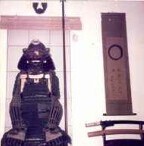

.thumb.jpeg.b6781a624c1ec57b977889a7af4fe096.jpeg)

.thumb.jpeg.e9fc11192f15aba3a226ef366431eb80.jpeg)








